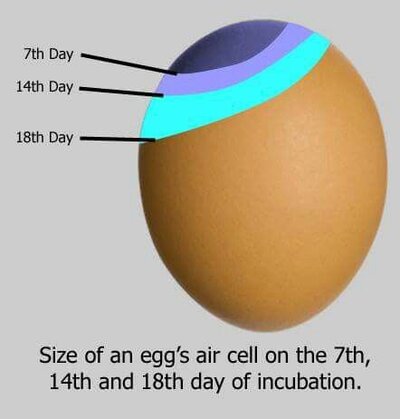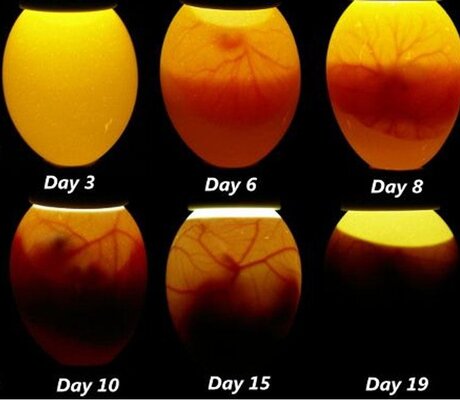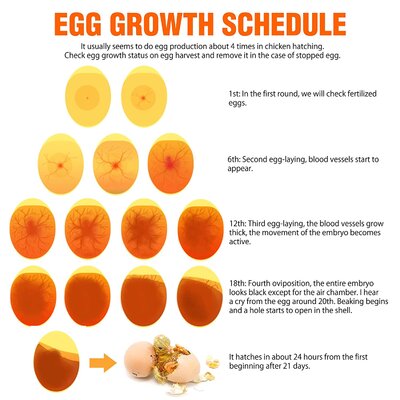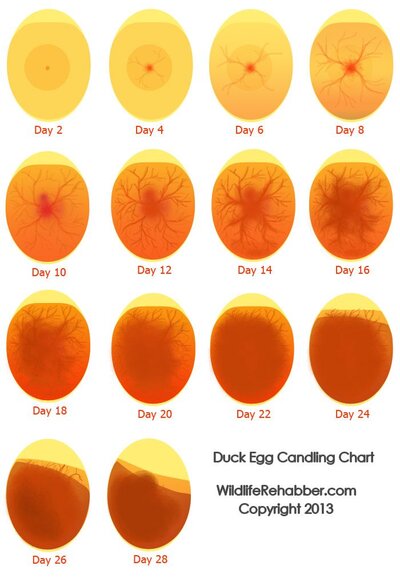The second most exciting part of incubating and hatching eggs has to be candling! Second only to watching the little chicks pop out of their shells, it is so rewarding to watch the tiny embryos grow and develop from the tiniest blastoderm to a full sized chick that fills the egg!
I'm starting this thread to offer a place for people to ask questions about candling as well as to share tips and tricks to safely candle and take pictures while candling.

It's recommended to candle at least 3 times during incubation to monitor air cell development (to make sure the eggs are losing the appropriate amount of weight) and to discard any non-developing eggs or quitters. I typically candle more often and this has never been detrimental to my hatches, just make sure to wash and dry your hands thoroughly before handling the eggs. This is to ensure that you aren't introducing oils from your skin that could clog the porous shell and to wash away any dirt, or bacteria that you could have come into contact with before handling.

I also recommend candling in front of your incubators whenever possible, this reduces the chances of accidents happening from dropping the eggs. As you can see in the above image I also like to keep a folded fluffy towel in front of them for a padded area to candle.

Candling from the side in early development you will still be able to see the embryo well, but as the chick develops it's much easier to see the chicks developing when candling from the air cell (the rounded end of the egg). It won't hurt anything if you candle from the pointed end or the side, it's just much easier to see inside the egg from the air cell end.
To better see development, it's always best to candle in a completely dark room at night. The less light pollution you have in the room the better you will be able to make out what's going on inside the egg. If you only close the blinds and turn off the light during the day, you may be able to see the developing chicks but you might miss out on SEEING the heartbeat!
Did you know: A chick's heart forms and begins to beat on day 2 of incubation! In only 25 hours of incubation, the heart begins to form, in 42 hours the heart begins to beat. If you have a light colored chicken egg you might even be able to see the heart beating with the naked eye between day 3-6 of incubation.

When taking pictures, it can sometimes be difficult to show others what you're seeing in person. Sometimes simply changing the image to black and white can really make those details pop!

When candling dark eggs, such as Marans it can sometimes feel like you're trying to candle a rock and it just seems impossible to know if there is a chick developing inside. When all else fails, I recommend "the sniff test". That's simply smelling the eggs to make sure there is no foul odor coming from them and that there isn't any oozing coming from the eggs signifying that there is bacterial overgrowth. Any stinky eggs should be removed from the incubator and disposed of.

I'm starting this thread to offer a place for people to ask questions about candling as well as to share tips and tricks to safely candle and take pictures while candling.
It's recommended to candle at least 3 times during incubation to monitor air cell development (to make sure the eggs are losing the appropriate amount of weight) and to discard any non-developing eggs or quitters. I typically candle more often and this has never been detrimental to my hatches, just make sure to wash and dry your hands thoroughly before handling the eggs. This is to ensure that you aren't introducing oils from your skin that could clog the porous shell and to wash away any dirt, or bacteria that you could have come into contact with before handling.
I also recommend candling in front of your incubators whenever possible, this reduces the chances of accidents happening from dropping the eggs. As you can see in the above image I also like to keep a folded fluffy towel in front of them for a padded area to candle.
Candling from the side in early development you will still be able to see the embryo well, but as the chick develops it's much easier to see the chicks developing when candling from the air cell (the rounded end of the egg). It won't hurt anything if you candle from the pointed end or the side, it's just much easier to see inside the egg from the air cell end.
To better see development, it's always best to candle in a completely dark room at night. The less light pollution you have in the room the better you will be able to make out what's going on inside the egg. If you only close the blinds and turn off the light during the day, you may be able to see the developing chicks but you might miss out on SEEING the heartbeat!
Did you know: A chick's heart forms and begins to beat on day 2 of incubation! In only 25 hours of incubation, the heart begins to form, in 42 hours the heart begins to beat. If you have a light colored chicken egg you might even be able to see the heart beating with the naked eye between day 3-6 of incubation.
When taking pictures, it can sometimes be difficult to show others what you're seeing in person. Sometimes simply changing the image to black and white can really make those details pop!
When candling dark eggs, such as Marans it can sometimes feel like you're trying to candle a rock and it just seems impossible to know if there is a chick developing inside. When all else fails, I recommend "the sniff test". That's simply smelling the eggs to make sure there is no foul odor coming from them and that there isn't any oozing coming from the eggs signifying that there is bacterial overgrowth. Any stinky eggs should be removed from the incubator and disposed of.
Last edited:







